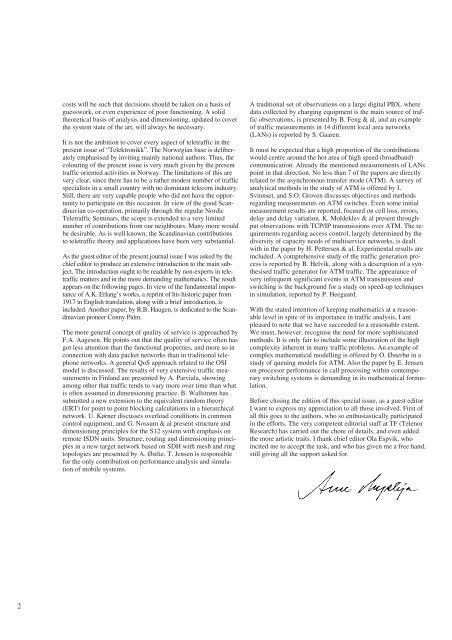Contents Telektronikk - Telenor
Contents Telektronikk - Telenor
Contents Telektronikk - Telenor
Create successful ePaper yourself
Turn your PDF publications into a flip-book with our unique Google optimized e-Paper software.
2<br />
costs will be such that decisions should be taken on a basis of<br />
guesswork, or even experience of poor functioning. A solid<br />
theoretical basis of analysis and dimensioning, updated to cover<br />
the system state of the art, will always be necessary.<br />
It is not the ambition to cover every aspect of teletraffic in the<br />
present issue of “<strong>Telektronikk</strong>”. The Norwegian base is deliberately<br />
emphasised by inviting mainly national authors. Thus, the<br />
colouring of the present issue is very much given by the present<br />
traffic oriented activities in Norway. The limitations of this are<br />
very clear, since there has to be a rather modest number of traffic<br />
specialists in a small country with no dominant telecom industry.<br />
Still, there are very capable people who did not have the opportunity<br />
to participate on this occasion. In view of the good Scandinavian<br />
co-operation, primarily through the regular Nordic<br />
Teletraffic Seminars, the scope is extended to a very limited<br />
number of contributions from our neighbours. Many more would<br />
be desirable. As is well known, the Scandinavian contributions<br />
to teletraffic theory and applications have been very substantial.<br />
As the guest editor of the present journal issue I was asked by the<br />
chief editor to produce an extensive introduction to the main subject.<br />
The introduction ought to be readable by non-experts in teletraffic<br />
matters and in the more demanding mathematics. The result<br />
appears on the following pages. In view of the fundamental importance<br />
of A.K. Erlang’s works, a reprint of his historic paper from<br />
1917 in English translation, along with a brief introduction, is<br />
included. Another paper, by R.B. Haugen, is dedicated to the Scandinavian<br />
pioneer Conny Palm.<br />
The more general concept of quality of service is approached by<br />
F.A. Aagesen. He points out that the quality of service often has<br />
got less attention than the functional properties, and more so in<br />
connection with data packet networks than in traditional telephone<br />
networks. A general QoS approach related to the OSI<br />
model is discussed. The results of very extensive traffic measurements<br />
in Finland are presented by A. Parviala, showing<br />
among other that traffic tends to vary more over time than what<br />
is often assumed in dimensioning practice. B. Wallstrøm has<br />
submitted a new extension to the equivalent random theory<br />
(ERT) for point to point blocking calculations in a hierarchical<br />
network. U. Kørner discusses overload conditions in common<br />
control equipment, and G. Nossum & al present structure and<br />
dimensioning principles for the S12 system with emphasis on<br />
remote ISDN units. Structure, routing and dimensioning principles<br />
in a new target network based on SDH with mesh and ring<br />
topologies are presented by A. Østlie. T. Jensen is responsible<br />
for the only contribution on performance analysis and simulation<br />
of mobile systems.<br />
A traditional set of observations on a large digital PBX, where<br />
data collected by charging equipment is the main source of traffic<br />
observations, is presented by B. Feng & al, and an example<br />
of traffic measurements in 14 different local area networks<br />
(LANs) is reported by S. Gaaren.<br />
It must be expected that a high proportion of the contributions<br />
would centre around the hot area of high speed (broadband)<br />
communication. Already the mentioned measurements of LANs<br />
point in that direction. No less than 7 of the papers are directly<br />
related to the asynchronous transfer mode (ATM). A survey of<br />
analytical methods in the study of ATM is offered by I.<br />
Svinnset, and S.O. Groven discusses objectives and methods<br />
regarding measurements on ATM switches. Even some initial<br />
measurement results are reported, focused on cell loss, errors,<br />
delay and delay variation. K. Moldeklev & al present throughput<br />
observations with TCP/IP transmissions over ATM. The requirements<br />
regarding access control, largely determined by the<br />
diversity of capacity needs of multiservice networks, is dealt<br />
with in the paper by H. Pettersen & al. Experimental results are<br />
included. A comprehensive study of the traffic generation process<br />
is reported by B. Helvik, along with a description of a synthesised<br />
traffic generator for ATM traffic. The appearance of<br />
very infrequent significant events in ATM transmission and<br />
switching is the background for a study on speed-up techniques<br />
in simulation, reported by P. Heegaard.<br />
With the stated intention of keeping mathematics at a reasonable<br />
level in spite of its importance in traffic analysis, I am<br />
pleased to note that we have succeeded to a reasonable extent.<br />
We must, however, recognise the need for more sophisticated<br />
methods. It is only fair to include some illustration of the high<br />
complexity inherent in many traffic problems. An example of<br />
complex mathematical modelling is offered by O. Østerbø in a<br />
study of queuing models for ATM. Also the paper by E. Jensen<br />
on processor performance in call processing within contemporary<br />
switching systems is demanding in its mathematical formulation.<br />
Before closing the edition of this special issue, as a guest editor<br />
I want to express my appreciation to all those involved. First of<br />
all this goes to the authors, who so enthusiastically participated<br />
in the efforts. The very competent editorial staff at TF (<strong>Telenor</strong><br />
Research) has carried out the chore of details, and even added<br />
the more artistic traits. I thank chief editor Ola Espvik, who<br />
incited me to accept the task, and who has given me a free hand,<br />
still giving all the support asked for.

















